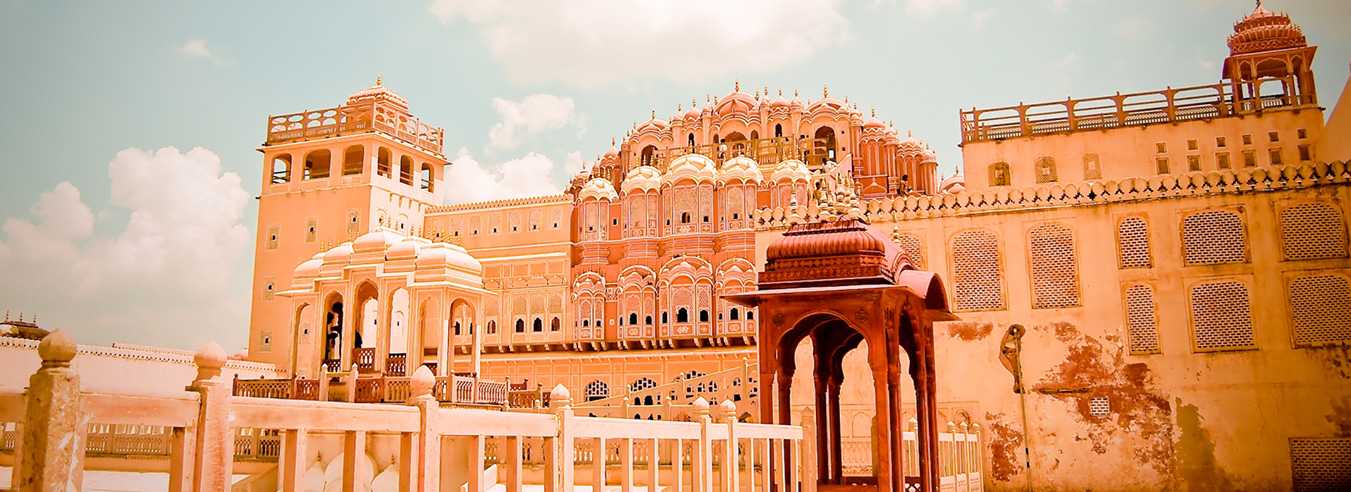
Pink City Jaipur is amongst the most visited tourist destinations in India and seventh best places to visit in Asia. It is due to the SAMODE, called Samod in Hindi, means ‘Heritage Monuments and Structures’ built by the Kings, the Noble Families and the Land Lords of Rajasthan. Main tourist attractions of Jaipur are Samode Palaces, Samode Havelis and Samode Baghs (Gardens).
*Amer Palace:
Amer Palace or Amber Palace is one of the top attractions among the tourists visiting Jaipur. This beautiful palace is inside Amer Fort built over the top of a hill located 11 kilometers from the main city. Amer Fort is an extensive complex of Amer Palace built with pale yellow and pink sandstone and white marble. There are two entrance gates Suraj Pol and Chand Pol, both opens in the main courtyard of the Fort. The fort is divided into four sections each having their own courtyard. There are lots of attractions for visitors in Amer Fort, as Diwan-e-Aam, Sheesh Mahal, Temples with Rajasthani architecture and a huge tunnel connecting Amer Fort to Jaigarh Fort. A light and sound show is being organized within the fort daily for visitors to introduce the history of the fort.
Timings: 8:00 am to 5:30 pm , Entry Fee: Rs.25.00 for Indian visitors and Rs.550.00 for foreign tourists, Rs. 10.00 for Indian students and Rs.100.00 for foreigner students.
How to reach: Nearest Metro Station- Sindhi Camp Metro Station, Buses for Amer Fort ply frequently from Ajmeri Gate and MI Road bus stations which take about 45 minutes, also cabs and auto rickshaws are available anytime and anywhere.
*City Palace:
The City Palace is a popular heritage site located in the heart of Pink City. This beautiful palace is built by Maharaja Sawai Jai Singh II in 1732. This palace includes many buildings, spacious courtyard, huge wells and attractive gardens. The palace is made of red and pink sandstone and white marble. Mesmerizing paintings, finely cut stonework done on the walls and architectures of the palace attract the visitors of India and abroad. There are many famous monuments inside the palace such as Chandra Mahal, Mubarak Mahal, Mukut Mahal, Maharani Mahal, Govind Dev Temple and City Palace Museum. City Palace has a Queen’s Palace where the traditional weapons of ancient Rajputana army were stored, which include ivory swords, chain weapons, guns, pistols, cannons, poison tip arrows and gun powder pouches are kept here. The palace complex has four entrance gates, two of them Uday Pol and Virendra Pol are for visitors; Tripolia Gate is being used by the members of Royal Family and rest one Soldiers Gate is not in operation for a long time.
Timings: 9:00 am to 5:00 pm. Entry Fee: Rs. 75.00 for Indian citizen, Rs. 300.00 for foreigners and Rs. 40.00 for students.
How to Reach: Nearest Metro Station- Sindhi Camp Metro Station, Buses ply at regular intervals from Ajmeri Gate and MI Road bus stations, Cabs and Taxies are also available anytime and anywhere.
*Ishwar Lat:
Ishwar Lat or Swargasuli or Sargasooli or Heaven Piercing Minaret is a tall tower near Tripoli Gate of City Palace. It is built by Sawai Ishwari Singh in 1749 as a symbol of his grand victory against his brother Madho Singh in the war of Bagru. It is known for the breathtaking view of Jaipur City when seen from its top. It a challenge for anybody to climb the tower to the top as it is a test of fitness of the climber. There is another story popular among the people about the construction of this tower. Sawai Ishwar Singh had built the tower to see the beautiful daughter of his Prime Minister Hargovind Natani. Ishwar Singh the King falls in love with the beautiful girl but due to royal protocol he could not meet her in her house so he built the tower to stare her beauty. Further ahead on the left is the impressive Tripoli Gate and the Chaura Rasta beyond the gate.
Timings: 24X7 open, Entry Fee: Rs. 20.
How to Reach: Nearest Metro Station- Sindhi Camp Metro Station, Buses ply at regular intervals from Ajmeri Gate and MI Road bus stations, Cabs and Taxies are also available anytime and anywhere.
*Nahargarh Fort:
Nahargarh Fort is one of the prime tourist destinations in Jaipur. Nahargarh Fort is the proud of Rajputana reign situated on the ridge of Aravalli Hills, creating an impressive northern backdrop to the city of Jaipur. The fort was constructed during the reign of Maharaja Jai Singh in 1734 and was later expanded in 1868 by Maharaja Ram Singh. The fort is dedicated to Prince Nahar Singh Bhomia. Nahargarh means the abode of tigers, was formidable barrier to defend Jaipur against attacks of enemies. The external walls of the fort are made of hard and rough stone while the inside walls are made from pink sandstone. Within its walls the fort houses Madhavendra Bhawan, the summer destination for the members of the royal family. Raja Sawai Madho Singh had built 12 suits for the queens and at the head of which a big suit for the king. All these suits are connected by corridors decorated with delicate murals. The fort looks brilliant in full moon night and flood light. This fort is a popular film shooting location, some of the films shot here are Rang De Basnti and Jodha Akbar. Cycling and Trekking are two activities being organized for visitors taking additional fees. Nahargarh Fort has so many other attractions also such as;
Jaipur Wax Museum: Jaipur Wax Museum is the first wax museum in the world to be opened at a heritage site. It is also known as Nahargarh Wax Museum as it is located inside the fort. This museum has over 30 life-like wax statues of famous personalities from different fields. Here is displayed a wax statue of 10 feet long Royal Enfield Bullet named Gati-Gamini, the signature of Rajasthan Tourism Motorbike.
Royal Darbar: The Nahargarh Wax Museum ‘Royal Darbar’ section consists of the majestic life-like statues of the Maharajas and the Maharanis of Jaipur kingdom. This section of the museum introduces the visitors about the sense of royalty in the Rajputana Dynasty. Visitors like to see hand painted pure gold motifs that are inspired from the glorious history of Rajputana Dynasty. Generally visitors like to have a click in a royal setting with a Maharaja costume.
Hall of Icons: The Hall of Icons is most popular section of the Nahargarh Wax Museum, this hall is full of wax statues of renowned national and international personalities such as Amitabh Bachchan, Mahatma Gandhi, Bhagat Singh, Ravindranath Tagore, Albert Einstein, Maharaja Sawai Jai Singh II and Maharani Gayatri Devi.
Sheesh Mahal: Sheesh Mahal is an extension of Nahargarh Wax Museum, as It was built hundreds of years ago in 16th century by Raja Maan Singh, later on it became the part of the museum. The walls and the pillars of the palace have been revamped and studded with high quality gold-amalgam mirrors to regain its glory.
Timings: 10:00 am to 5:30 pm daily, Entry Fee: Rs. 50.00 for Indian citizen and Rs. 200 for foreigners, Rs 5.00 for students (Indian), Rs.25.00 for students (foreign). Museum Section of the Fort has separate visiting charges as Rs. 500.00 for Indian and Rs. 700.00 for foreign citizen.
How to Reach: Buses ply at regular intervals from Ajmeri Gate and MI Road bus stations, Cabs and Taxies are also available anytime and anywhere.
*Madhavendra Palace:
Madhavendra Palace is one of the most prominent tourist places in the city of Jaipur. The palace is located inside the famous fort of Nahargarh. Madhavendra Palace is a beautiful double storied building built by Maharaja Sawai Ram Singh for his nine queens. The palace has nine apartments beautifully decorated with flower motifs and mesmerizing murals which elevate the spacious courtyards. The palace is about 15 km from main city Jaipur and at a height of 250 m. nine apartments for queens surround three sides of the palace and the fourth side houses the living room of Maharaja. With its magnificent views, inspiring wall paintings and the heritage touch of Rajasthani culture, Madhavendra Palace has become the attraction for tourists. Government of Rajasthan has decided to build a Sculpture Park in the Palace complex in 2017 and invited many artists from all parts of India and also from some other countries to contribute in the project. The work started immediately and the beautiful Sculpture-Park came into existence in 2021.
Timings: 10:00 am to 5:30 pm daily, Entry Fee: Rs. 50.00 for Indian citizen and Rs. 200 for foreigners, Rs 5.00 for students (Indian), Rs.25.00 for students (foreign).
How to Reach: Buses ply at regular intervals from Ajmeri Gate and MI Road bus stations, Cabs and Taxies are also available anytime and anywhere.
*Jaigarh Fort:
Jaigarh Fort is an example of bespoke architecture i e the structure designed according to the requirements of the construction. The fort is built with typical red sandstone that is the predominant material used in most of the Rajput and Mughal forts. Literally the name of the fort means the fort of victory. It was built by Maharaja Jai Singh II in 1726, in order to defend the unexpected attackers to the Amer Palace. The main purpose of the construction of this fort was connecting underground pathway between Amer Fort and Jaigarh Fort to help people reach safely in case of attack. The fort provides an excellent view of the Aravalli Range and Maota Lake and actually built atop Cheel ka Teela i e the hill of eagles. Its architecture is quite similar to Amer Fort. It had served as temporary residence of many kings and permanent store of weapons, artillery and ammunitions of Rajput rulers. During the reign of Mughal emperor Shahjahan, Jaigarh Fort was considered to be world’s most efficient cannon foundry. The visitors like to witness the most exquisite architectural gems like Aram Mandir, Lalit Mandir, Lakshmi Vilas Mandir, Ram Harihar Mandir and Bhairav Mandir in the premises. One of the main attractions of the fort is ‘Jaivana Cannon’, the largest cannon on the wheels.
Timings: 9:00 am to 4:30 pm daily, Entry Fee: Rs. 35 for Indian citizen and Rs. 85 for foreigners.
How to Reach: : Nearest Metro Station- Sindhi Camp Metro Station, Buses for Amer Fort ply frequently from Ajmeri Gate and MI Road bus stations which take about 45 minutes, also cabs and auto rickshaws are available anytime and anywhere.
*Sisodia Rani Palace & Sisodia Rani ka Bagh:
Sisodia Rani Palace and Garden is located nearly 10 km. from main city Jaipur on the Jaipur – Agra highway. This beautiful palace and garden is one of the most visited tourist spots in the Pink City. The best time to visit here is October to March when cool breeze and pleasant environment add in the comfort of visitors. The palace and the royal multitier garden were built by Maharaja Sawai Jai Singh II as a quiet retreat for his second wife Rani Sisodia. Shooting of Bollywood Hindi movie Lamhe was done here in 1991. The two storey building of palace in made of red sand stone and the inner walls are decorated with colorful murals. Walls contain paintings of hunting scenes and some mythical creatures. The garden is laid out in Charbagh style, a common Rajputana style featuring most of the gardens in and around Jaipur. Rectilinear shape, gurgling waterways, spouting fountains and well crafted structures as well as several decorative pavilions make the garden a perfect choice for visitors.
Timings: 9:00 am to 5:30 pm daily, Entry Fee: Rs. 50.00 for Indian citizen and Rs. 200 for foreigners.
How to Reach: Cabs are the best option.
*Vidyadhar Garden:
Vidyadhar Garden in Jaipur is a quaint little place in the heart of the city near Ghat ki Guni, very close to the Sisodia Rani ka Bagh on Jaipur – Agra highway. Vidyadhar Garden is one of the well maintained gardens in Jaipur in the proper authentic guidance of Rajasthan government. The most predominant flora here is the Alstonia trees (a widespread genus of evergreen plants) as the garden is filled with them. The garden is full of peacocks, immigrant birds and monkeys, visitors enjoy their beautiful presence also. Vidyadhar Garden is the best place for nature lovers and art lovers. This garden has been built by Rajasthan Tourism in 1988 as a tribute to Jaipur’s chief architect Vidyadhar Bhattacharya and designed according to the principles of Shilpa Shashtra, the science of Indian architecture. The garden is divided into three complexes Vidyadhar Palace, Neela Mahal and Raj Niwas. All three complexes are connected with a huge courtyard but all three complexes have their own separate colors, designs and craft works.
Timings: 8:00 am to 5:30 pm, Entry Fee: Rs.25.00 for Indian visitors and Rs.550.00 for foreign tourists, Rs. 10.00 for Indian students and Rs.100.00 for foreigner students.
How to Reach: Cabs are the best option.
*Ram Niwas Garden:
Ram Niwas Garden is located in the heart of the Pink City at Jawahar Lal Nehru Marg, Ashok Nagar. The garden is one of the prominent attractions of 19th century gardens of Kachhwaha Dynasty. Over the years, from the time it was built in 1868 by Maharaja Sawai Ram Singh the garden had undergone significant number of renovations to add elegance to its look. Tourists from all over world visit Ram Niwas Garden to witness the royalty and mastery of the colonial designs. The garden has little corners with cafes that specialized in authentic Rajasthani local delicacies where the visitors can grab a bite. The garden has many attractions for history and architecture lovers, bird watchers, nature lovers including Botany and Zoology enthusiasts. People interested in shopping can visit Bapu Bazaar located around the corner of Ram Niwas Garden. Some other attractions of Ram Niwas Garden are:
Albert Hall Museum: This is a museum built in an architectural style which has blends of English and North Indian elements of architecture. This is the oldest museum in Rajasthan, these days also known as Central Museum and is located just opposite the Ajmeri Gate of Ram Niwas Garden. The foundation stone of the museum was laid by the Prince of Wales Albert Edward in 1876 and hence name after him. The museum has lots of evidences of rich and prosperous heritage and culture of Rajputana Kings and their empire.
Ravindra Rang Manch Theatre: Ravindra Rang Manch is all about art, method acting and plays. Classical music, classical dances and mythological plays are being performed here by traditional artists as well as new modern artists. The entry to the Rang Manch is by invitation only so interested person should arrange the entry pass one day before visiting here.
The Art Gallery: Art Gallery is situated on the first floor of Ravindra Rang Manch Theatre, lined with numerous sculptures created by famous artists all over world.
Jaipur Zoological Garden: Jaipur Zoo was built in 1877 as a part of Ram Niwas Garden and is considered to be the oldest zoo in India. It is famous for the crocodile breeding farm. The zoo consists of nearly 121 species of animals and birds.
Timings: 8:30 am to 5:30 pm. Entry Fee: The garden, the museum, the rang manch and the zoo all have separate entry fees, Entry Fee for the garden is Rs.10 and Rs.100 for Indian citizens and foreigners respectively.
How to Reach: Cabs and taxies are available anytime from anywhere.
*Jai Niwas Udyan Govind Dev Ji:
Jai Niwas Udyan Govind Dev Ji is a beautiful garden located Amer Road Kanwar Nagar Jaipur. Among many gardens in Jaipur, Jai Niwas Garden is very popular in visitors which include tourists as well as devotees of Lord Krishna in Govind Dev Ji Temple inside the garden. Having a number of beautiful plants and some splendid structures, the sight of the garden is a treat to the eyes of the visitors. The design of the garden has a touch of typical Mughal Charbagh pattern. Apart from the excellent look that the garden boasts of, the garden has a number of other attractions for the visitors. Jai Niwas Garden has a miniature temple of Lord Krishna known as Govind Dev Ji Mandir.
Timings: 5:00 am to 10:00 pm. Entry Fee: Free
How to Reach: Cabs and taxies are available anytime from anywhere.
*Nahargarh Biological Park:
Nahargarh Biological Park is a part of Nahargarh Sanctuary located on Jaipur Delhi highway. It is expanded in an area about 700 hectares and full of varieties of plants, trees, shrubs, herbs, birds and animals. It is not only a place to visit for amusement but also a vast study center for nature lovers and a big research center for scholars interested in the development of plants and animals. There are nearly 300 species of birds and 200 species of animals housing in the sanctuary. White Napped Tit is a bird only be found here. Nahargarh Biological Park has Asiatic Lions, Bengal Tigers, panthers, hyenas, wolves, deer, crocodiles, sloth bear, Himalayan Black Bear, wild boar etc. to watch.
Timings: 15th March to 14 October-8:30 am to 5:30 pm, 15th October to 14 March- 9:00 am to 5:00 pm. Entry Fee: Indian-Rs.50.00, Foreigners-Rs.300.00, Students-Rs.20.00.
How to Reach: Cabs and taxies are available anytime from anywhere.
*Jhalana Safari:
Jhalana Leopard Safari Park is the home of more than 30 leopards out of which 8 to 10 can be easily seen in tourism area. The safari is situated in the heart of the city, near Jaipur airport. Jhalana has become a favorite destination for tourists who want to spot leopards in wild. Except leopards Jhalana Safari has become houses for many other smaller wild animals such as spotted deer, blue bulls, wild boars so many resident and migratory birds. Jhalana Leopard Safari is a nonprofit wildlife park dedicated to conservation of animals and education to wildlife lovers.
Timings: 5:45 am to 8:30 am and again 4:30 pm to 7:15 pm. Entry Fee: Only online booking available and entry fee varies per day.
How to Reach: Cabs and taxies are available anytime from anywhere.
*Jantar Mantar:
Jantar Mantar is the largest stone made astronomical observatory in the world. It is located near the City Palace in the Royal City Jaipur. Owing to its rich cultural, heritage and scientific values Jantar Mantar in Jaipur has also been featured on UNESCO list of world heritage. It is ancient study center of astronomical science consisting nineteen instruments made of stone and brass and built by the King Sawai Jai Singh in 1733. Another fact that makes this destination unique is that the world’s largest sun-dial is situated here. Jantar Mantar observatory of Jaipur is a part of collection of the five such observatories built by King Sawai Jai Singh which are located in New Delhi, Ujjain, Varanasi and Mathura. A light and sound show is being organized here daily in evening time to entertain the visitors.
Timings: 9:00 am to 5:30 pm, Entry Fee: Rs. 40.00 for Indian citizen, Rs. 200.00 for foreigners and Rs. 15.00 for students.
How to Reach: Nearest Metro Station- Sindhi Camp Metro Station, Buses ply at regular intervals from Ajmeri Gate and MI Road bus stations, Cabs and Taxies are also available anytime and anywhere.
*Hawa Mahal:
The Palace of Breeze, Hawa Mahal is an extension to the City Palace situated at Badi Choupad, Pink City of Jaipur. It was built in 1799 by the Kachhwaha Rajput ruler Sawai Pratap Singh, grandson of Maharaja Sawai Jai Singh. It has 953 windows on the outside walls. The honeycomb shaped and beautifully carved windows allow breeze to blow through the palace and makes it a perfect summer palace. The five storied palace was built in the shape of Lord Krishna’s crown because King Sawai Pratap Singh was devoted to Bhagwan Krishna. The top three storeys have been named as Vichitra Mandir, Prakash Mandir and Hawa Mandir. First floor is named as Sharad Mandir and second floor as Ratan Mandir. The palace illuminates with golden sun light in the morning when the sun enters the rooms from the windows. Perhaps it was built to allow the Royal Ladies to enjoy everyday street scenes and Royal processions on the street without being seen by outsiders. The ‘Purdah-System’ at the time was strictly followed, Rajput royal ladies should not be seen by strangers, or appear in any public area.
Timings: 9:00 am to 4:30 pm daily, Entry Fee: Rs. 10.00 for Indian citizen and Rs. 50.00 for foreigners.
How to Reach: Nearest Metro Station- Sindhi Camp Metro Station, Buses ply at regular intervals from Ajmeri Gate and MI Road bus stations, Cabs and Taxies are also available anytime and anywhere.
*Jal Mahal:
Jal Mahal or the Water Palace is one of the most majestic places to visit in Jaipur. Jal Mahal is an example of marvelous architectural beauty and built in the center of Man Sagar Lake. In first look it gives illusion as floating on the surface of the lake. The palace is not too high and has four dome shaped pillars at four corners and a big one in the center. It is made of red sandstone and the interior is decorated with marble and murals. The palace was built by Maharaja Sawai Pratap Singh in 1799 with an idea to use it as a hunting lodge for his duck shooting adventures. In fact the palace has five floors but only one is visible above water level, rest four submerged in the lake due to formation of a dam in the edge of the hill surrounding the lake. Tourists are not allowed these days to visit inside the palace because it is converted into a restaurant, so visitors see it from the banks of the lake or taking a ride of motor boat to see the palace from all sides.
Timings: Since the entry to Jal Mahal has been restricted so there is no Entry Fee but a pathway around the Man Sagar Lake allows tourists to view Jal Mahal in the day time between 6:00 am to 6:00 pm.
How to Reach: Jal Mahal is located in Jaipur – Amer road 7 km. from main city. Cabs are the best options to reach here.
*Gaitore Jaipur:
Gaitore Jaipur is The Royal Cremation Ground of Kachhwaha Rajputs. Gaitore Jaipur is one of the most famous tourist attractions known for its beautiful blend of mediaeval architecture and typical Rajasthani decoration. Gaitore is famous for its cenotaphs of Royal Kings of Kachhwaha Rajputs, Gaitore is in fact pronounced as ‘Gaye ka Thor’ means resting place of departed soul. It is located at a distance of 15 km from Jaipur city on Jaipur-Amer road. This cremation site has many cenotaphs for each Maharaja of Jaipur. These royal cenotaphs have artistically Rajasthani carvings on white marble. Each and every Maharaja of Jaipur has his cenotaph except Maharaja Sawai Ishwari Singh who was cremated behind Chandra Mahal, City Palace complex.
Timings: 10:00 am to 5:00 pm, Entry Fee: Rs.30.00 for Indian and Rs. 100.00 for foreign citizen.
How to Reach: Cabs and taxies are available anytime from anywhere.
*Maharani Ki Chhatri:
Maharani ki Chhatri is Cremation Ground of Royal Ladies of Rajput Empire of Jaipur. Here the cenotaphs of the Royal Ladies are present with the carvings about them. The cenotaphs are either made of white marble or with the local stone that were available in Jaipur. All the cenotaphs are covered with beautiful carved royal chhatris. Some of cenotaphs are not covered with chhatris and are still incomplete, but the information carved on the cenotaph tells the reason behind it, the queen who died before her husband had her cenotaph without chhatri. It is located at a distance of about 10 km from main city in Amer road just before the Ramgarh road crossing.
Timings: 9:30 am to 4:30 pm, Entry Fee: Rs.30.00 for Indian and Rs. 100.00 for foreign citizen.
How to Reach: Cabs and taxies are available anytime from anywhere.
*Anokhi Museum:
Anokhi Museum of Hand Printing Jaipur is located nearly 13 km from the City at Sagard Road near Kheri Gate which is 1 km from Amer Palace. The museum is the brain child of Rachel Bracken Singh and her husband Pritam Singh, with the vision to conserve the age old crafts of ‘hand printing and block printing’. The Haveli which is converted into museum was built in 1989 with traditional pink sandstone walls and balconies in typical Rajasthani architecture. The museum is dedicated to the oldest Rajasthani traditional craft of hand block printing on cloths. The hall on the ground floor lays a huge board on which artists spared cloths into its most artistic form, reflecting the richness of diversity in the printing art. Apart from hand printing and block printings on the cloths, here the skilled artists of carving on wooden blocks and brass blocks, artists making colors from natural things like leaves, flowers, vegetables, indigo and turmeric can be seen here busy in their arts and crafts. The galleries in the museum as Gallery for Introduction, Haveli Restoration, Regional Textiles, Natural and Chemical Dyes, Block Printing, Gold and Silver Printing and Carving Tools have their displays for the visitors. Anokhi Archives where more than 100 types of garments, carving blocks, hand printed and block printed textiles and home furniture of traditional Rajputana era are displayed here for visitors. The museum has a workshop for learners and visitors interested to learn the art of printing and carving. There is a museum shop also where visitors can buy cloths, furniture, jewellery, books and handcrafts.
Timings: Monday to Saturday – 10: 30 am to 5: 00 pm, Sunday – 11:00 am to 4:30 pm. Entry Fee: Rs. 30.00, Rs. 20.00 and Rs. 15.00 for adults, students and children, respectively.
How to Reach: Nearest Metro Station- Sindhi Camp Metro Station, Buses ply at regular intervals from Ajmeri Gate and MI Road bus stations, Cabs and Taxies are also available anytime and anywhere.
*Statue Circle:
The iconic Statue Circle is one of the many attractive tourist spots in Jaipur. It is located near Central Park on Jai Singh circle in Ashok Nagar. Statue Circle is a tribute to the founder of Pink City Maharaja Sawai Jai Singh II, whose a life size white marble statue holding an astrological diagram in his hand is made in the center of the Statue Circle which is also the center of the Pink City. Charming atmosphere of the circle makes it an ideal place to hang out and enjoy the delightful breeze in evening and also to the morning walkers. Its magnificent lighting and dazzling fountains add to the vibrancy of the circle. The vendors sell here variety of traditional dishes, spicy snacks and regional cuisines for street food lovers.
Timings: 24X7 open, Entry Fee: Free.
How to Reach: Cabs and taxies are available anytime from anywhere.
*Central Park:
Central Park of Jaipur is the largest park with longest jogging strips and famous for the highest 206 feet high national flag post in India. The park was constructed in 2006 by Jaipur Development Authority and is home to one of Jaipur’s most lush green hubs at the center of the city with four entrance gates. Jaipur Central Park is the first choice for the birds lover visitors as this park is paradise for a variety of local and migratory birds. Here is a huge musical fountain that lights up after sun set and makes a prime attraction for visitors. The park is spread across an area of 129 acres and well fenced with stone walls. The 13 stone statues beside the post of national flag resemble the hedges, if watched closely. Their placement gives the shape of the constellation Capricorns. Since Central Park serves as a day picnic place for locals, there are rest rooms as well as clean drinking water facilities available for visitors. Due to its prime location, there are quite a few restaurants around the park that offer authentic Rajasthani food, Gujrati dishes, south Indian Dishes, North Indian Dishes and all sorts of snacks. For coffee lovers here is Saras Point at Statue Circle famous for best quality coffee.
Timings: 5:00 am to 9:00 pm, Entry Fee: Free.
How to Reach: Cabs and taxies are available anytime from anywhere.
Apart from the above places, visitors also like to visit some famous temples in Jaipur such as:
Birla Temple: Lakshmi-Narayan Temple, popularly known as Birla Temple is one of the most beautiful temples in Jaipur, located at the base of Moti Dungari, entirely made of white marble.
Govind Dev Ji Temple: It is a temple dedicated to Lord Krishna and located in the campus of Jai Niwas Udyan. It is believed that Maharaja Jai Singh had brought an idol of Lord Krishna from Vrindavan and established here.
Moti Dungari Ganesh Temple: A small hill Moti Dungari around which the Pink City flourishes houses a famous Ganesh temple built by Seth Jai Ram Paliwal in 18th century.
Digamber Jain Mandir: The ancient Digamber Jain Temple at Jaipur is in Sanganer, 14 km away from the city. The temple contains the idol of Lord Adinath in padmasan posture. The temple is made of red stone and has seven stories and eight sky touching shikhars (domes).
Galtaji Mandir: Galtaji is an ancient pilgrimage center located in the middle of low hills having many temples, pavilions and kunds (natural springs and water ponds). Ramgopalji Temple, popularly known as monkey temple and the Surya Mandir, the temple of Sun God are the main attractions of Galtaji.
Akshardham Temple: Akshardham Temple is one of the most visited temples in Jaipur. This is a beautiful temple made of marble and sandstone famous for its architectural carvings on its walls and dome. The temple is located in Vaishali Nagar, Jaipur.
Jagat Shiromani Temple: Jagat Shiromani Temple devoted to Lord Vishnu and Lord Krishna, is located in Amer, Jaipur. It is built in 1608 by Queen Kanakvati, the wife of King Maan Singh I, in the memory of her son Jagat Singh. It is an example of extraordinary architectural approach of the contemporary artists

Amer Palace or Amber Palace is one of the top attractions among the tourists visiting Jaipur. This beautiful palace is inside Amer Fort b...

The City Palace is a popular heritage site located in the heart of Pink City. This beautiful palace is built by Mahara...

Ishwar Lat or Swargasuli or Sargasooli or Heaven Piercing Minaret is a tall tower near Tripoli Gate of City Palace. It is built by Sawai...

Nahargarh Fort is one of the prime tourist destinations in Jaipur. Nahargarh Fort is the proud of Rajputana reign situated on the r...

Jaipur Wax Museum: Jaipur Wax Museum is the first wax museum in the world to be opened at a heritage site. It is also kn...
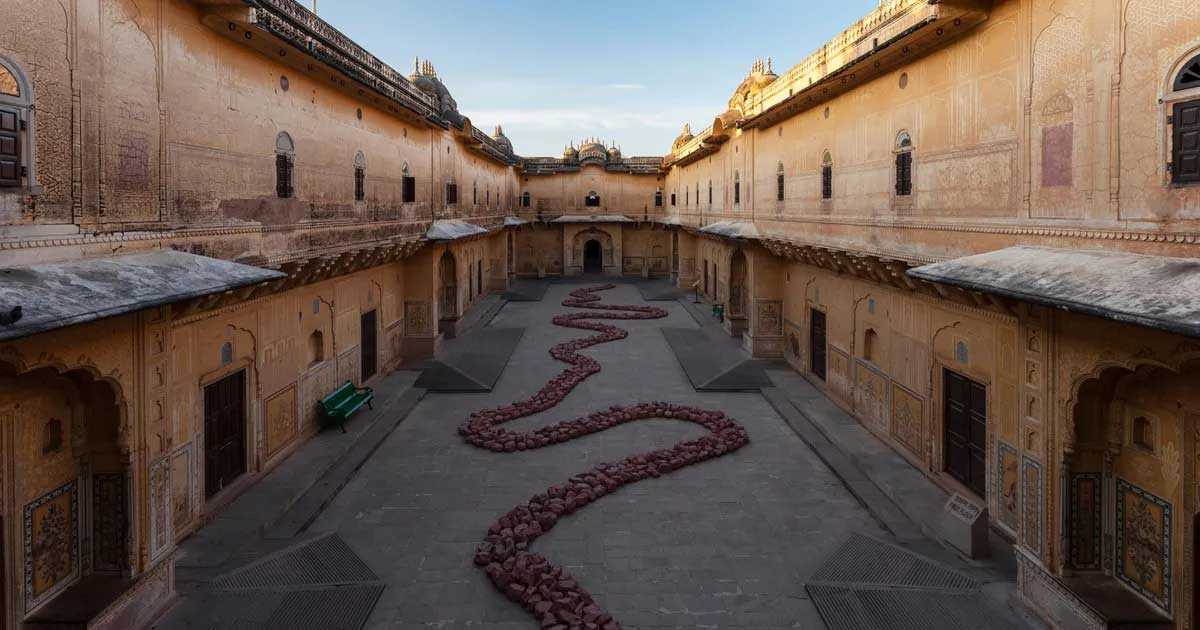
Madhavendra Palace is one of the most prominent tourist places in the city of Jaipur. The palace is located inside the famous fort of Nah...

Jaigarh Fort is an example of bespoke architecture i e the structure designed according to the requirements of the construction. The fort...

Sisodia Rani Palace and Garden is located nearly 10 km. from main city Jaipur on the Jaipur – Agra highway. This beautiful palace a...

Vidyadhar Garden in Jaipur is a quaint little place in the heart of the city near Ghat ki Guni, very close to the Sisodia Rani ka Bagh on...
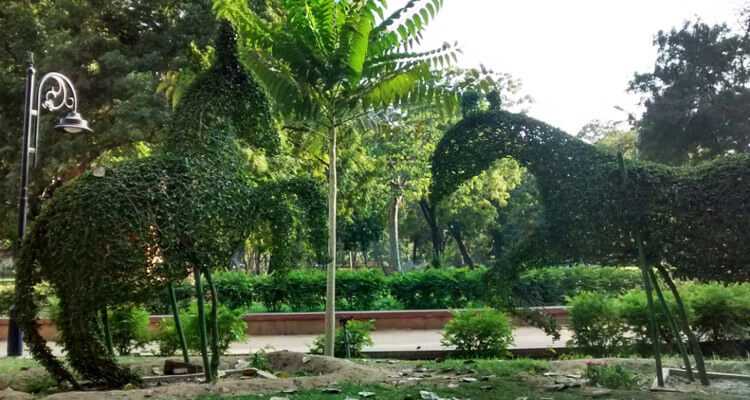
Ram Niwas Garden is located in the heart of the Pink City at Jawahar Lal Nehru Marg, Ashok Nagar. The garden is one of the prominent attr...

This is a museum built in an architectural style which has blends of English and North Indian elements of architecture. This is the oldes...

Ravindra Rang Manch is all about art, method acting and plays. Classical music, classical dances and mythological plays are being perform...

Jaipur Zoo was built in 1877 as a part of Ram Niwas Garden and is considered to be the oldest zoo in India. It is famous for the crocodil...

Jai Niwas Udyan Govind Dev Ji is a beautiful garden located Amer Road Kanwar Nagar Jaipur. Among many gardens in Jaipur, Jai Niwas Garden...

Nahargarh Biological Park is a part of Nahargarh Sanctuary located on Jaipur Delhi highway. It is expanded in an area about 700 hectares...
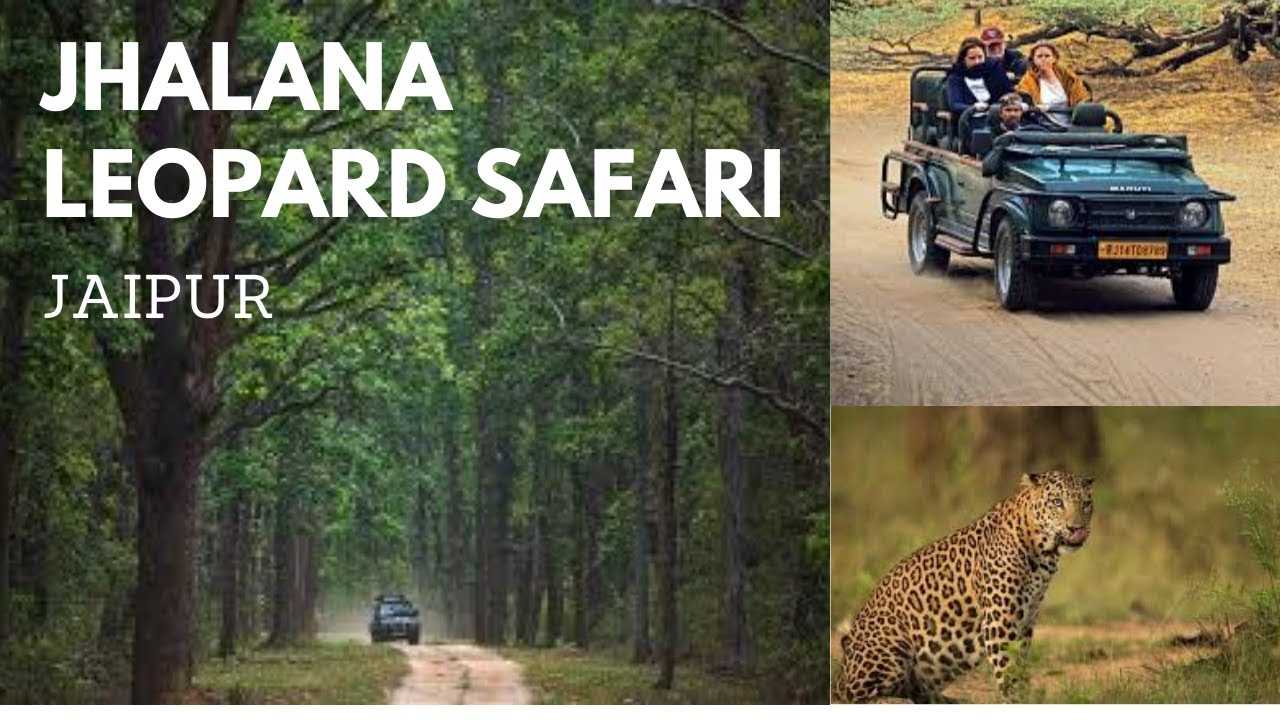
Jhalana Leopard Safari Park is the home of more than 30 leopards out of which 8 to 10 can be easily seen in tourism area. The safari is s...

Jantar Mantar is the largest stone made astronomical observatory in the world. It is located near the City Palace in the Royal City Jaipu...

The Palace of Breeze, Hawa Mahal is an extension to the City Palace situated at Badi Choupad, Pink City of Jaipur. It was built in 1799 b...

Jal Mahal or the Water Palace is one of the most majestic places to visit in Jaipur. Jal Mahal is an example of marvelous architectural b...
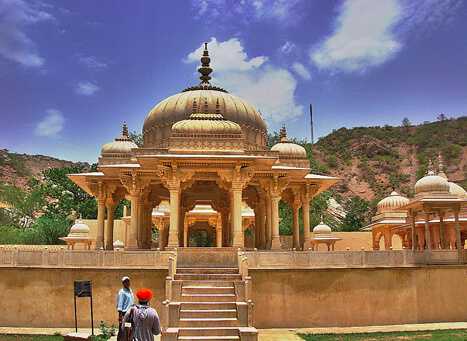
Gaitore Jaipur is The Royal Cremation Ground of Kachhwaha Rajputs. Gaitore Jaipur is one of the most famous tourist attractions known for...
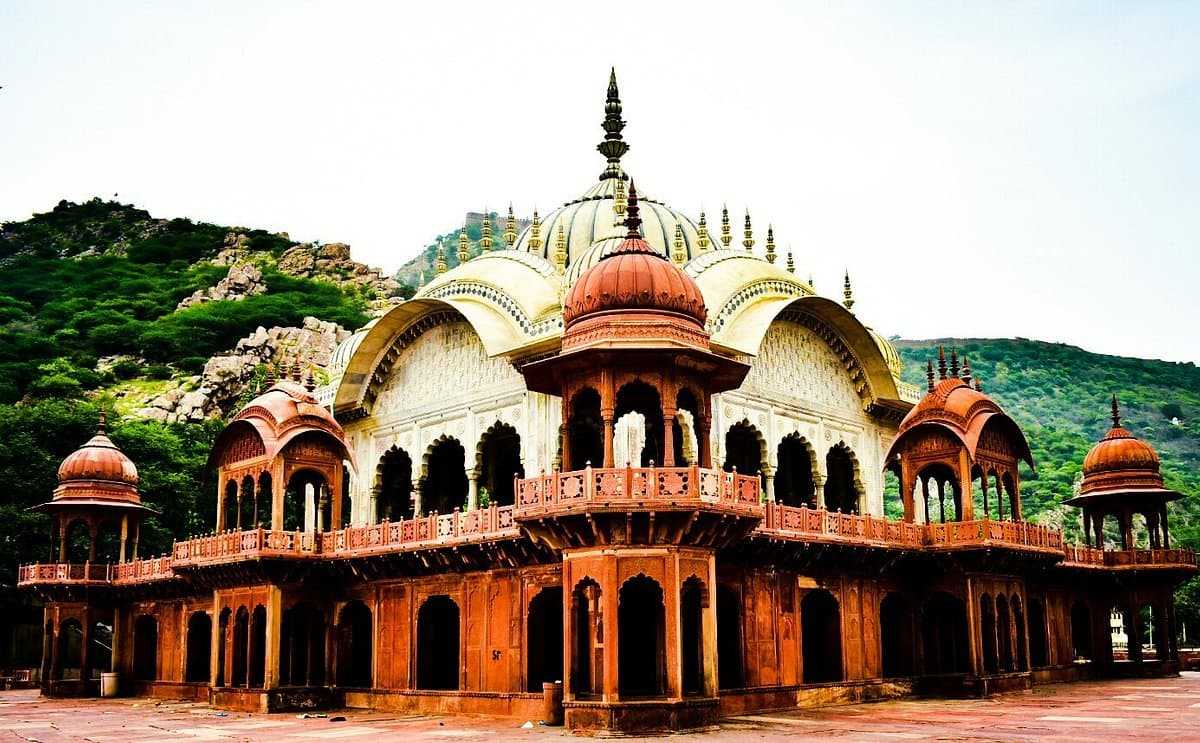
Maharani ki Chhatri is Cremation Ground of Royal Ladies of Rajput Empire of Jaipur. Here the cenotaphs of the Royal Ladies are present wi...

Anokhi Museum of Hand Printing Jaipur is located nearly 13 km from the City at Sagard Road near Kheri Gate which is 1 km from Amer Palace...

The iconic Statue Circle is one of the many attractive tourist spots in Jaipur. It is located near Central Park on Jai Singh circle in As...

Central Park of Jaipur is the largest park with longest jogging strips and famous for the highest 206 feet high national flag post in Ind...

Lakshmi-Narayan Temple, popularly known as Birla Temple is one of the most beautiful temples in Jaipur, located at the base of Moti Dunga...

It is a temple dedicated to Lord Krishna and located in the campus of Jai Niwas Udyan. It is believed that Maharaja Jai Singh had brought...

A small hill Moti Dungari around which the Pink City flourishes houses a famous Ganesh temple built by Seth Jai Ram Paliwal in 18th centu...

The ancient Digamber Jain Temple at Jaipur is in Sanganer, 14 km away from the city. The temple contains the idol of Lord Adinath in padm...

Galtaji is an ancient pilgrimage center located in the middle of low hills having many temples, pavilions and kunds (natural springs and...
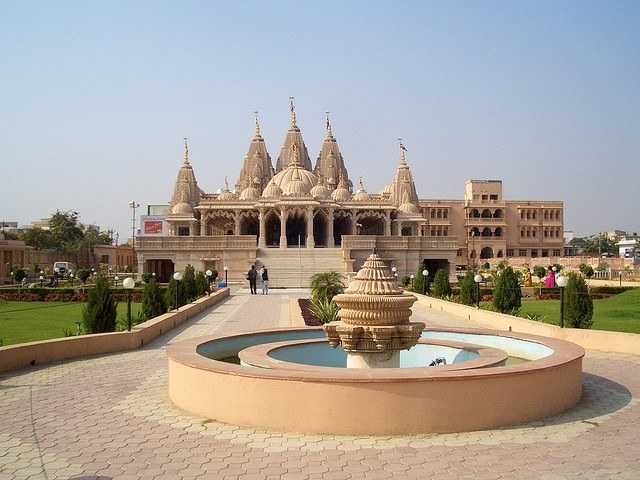
Akshardham Temple is one of the most visited temples in Jaipur. This is a beautiful temple made of marble and sandstone famous for its ar...

Jagat Shiromani Temple devoted to Lord Vishnu and Lord Krishna, is located in Amer, Jaipur. It is built in 1608 by Queen Kanakvati, the w...

Khaba Fort is a tourist destination where hardly some tourists like to visit, it is a deserted palace with no tourist crowd at all, ancie...
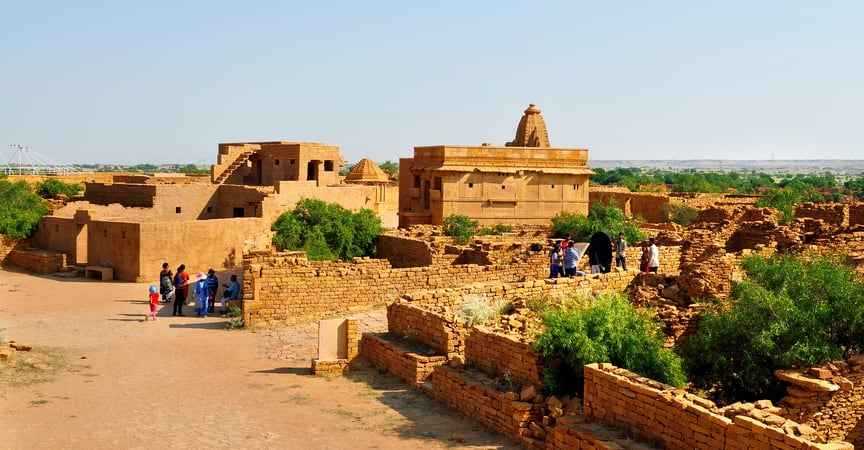
Kuldhara is a village in Jaisalmer which is known as the ‘village of ghosts’, seeing the abandoned village it seems that peop...
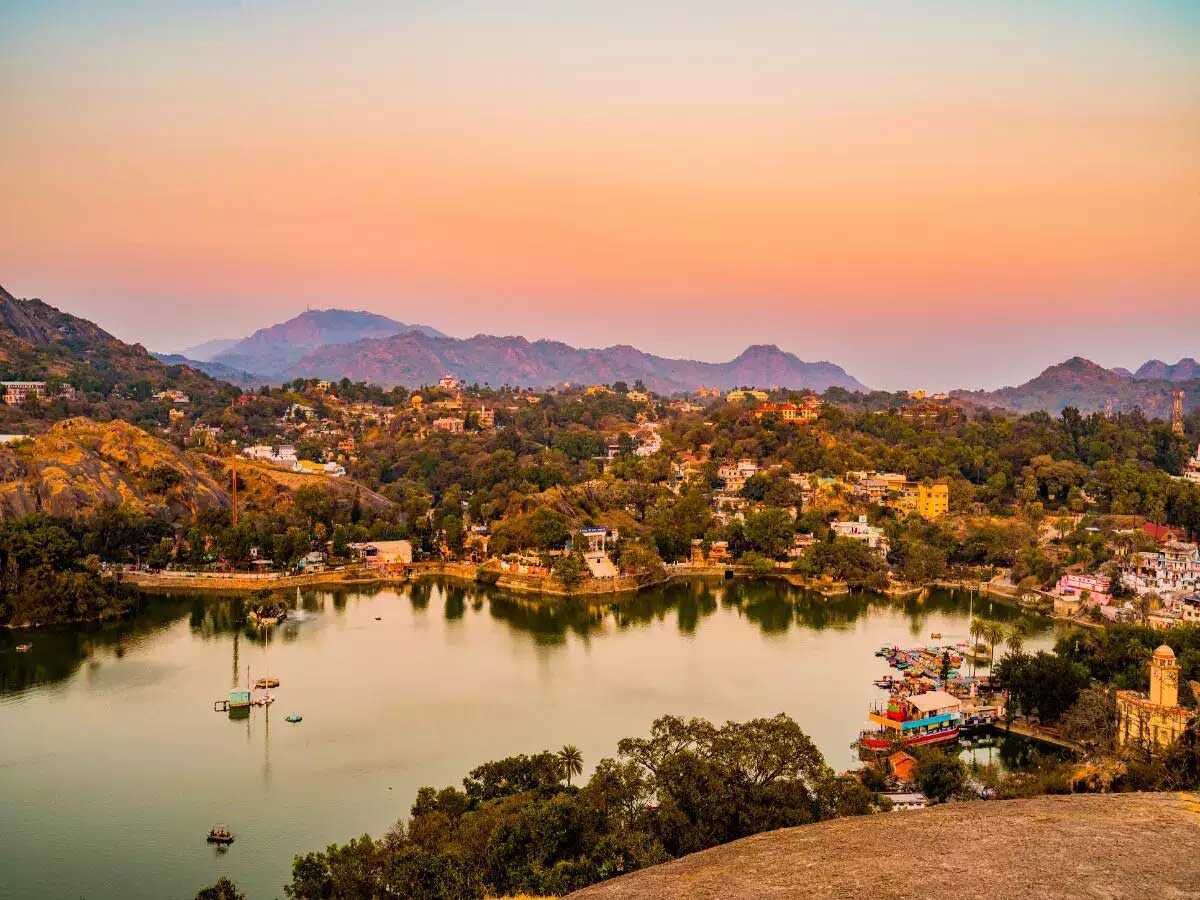

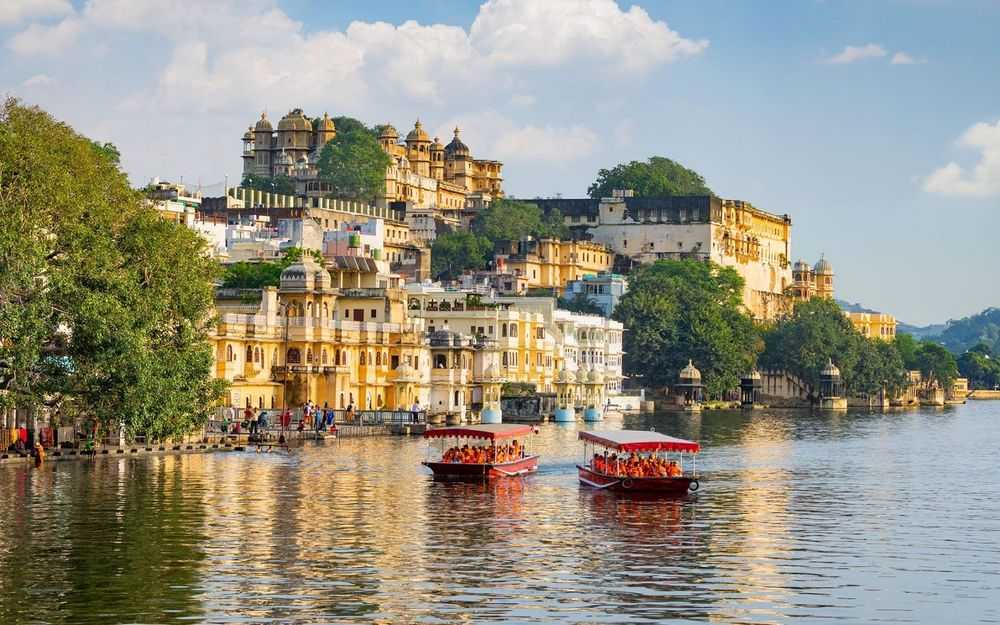
All Around the World Tours Dummy text ever since the 1500s, when an unknown printer took.
Immigration & Passport Help Dummy text ever since the 1500s, when an unknown printer took.
Private & Customized Tours Dummy text ever since the 1500s, when an unknown printer took.
All Around the World Tours Dummy text ever since the 1500s, when an unknown printer took.
Private & Customized Tours Dummy text ever since the 1500s, when an unknown printer took.
All Around the World Tours Dummy text ever since the 1500s, when an unknown printer took.
Immigration & Passport Help Dummy text ever since the 1500s, when an unknown printer took.
Private & Customized Tours Dummy text ever since the 1500s, when an unknown printer took.

Inspire you to explore India tours beyond the usual well-known locations.
Lorem ipsum dolor sit amet, consectetuer adipiscing elit. Aene an commodo ligula eget dolor. Aenean massa. Cum sociis the
Lorem ipsum dolor sit amet, consectetuer adipiscing elit. Aene an commodo ligula eget dolor. Aenean massa. Cum sociis the

Plan your day by day itinerary for your vacation with Private Car and Driver or Tour Packages.